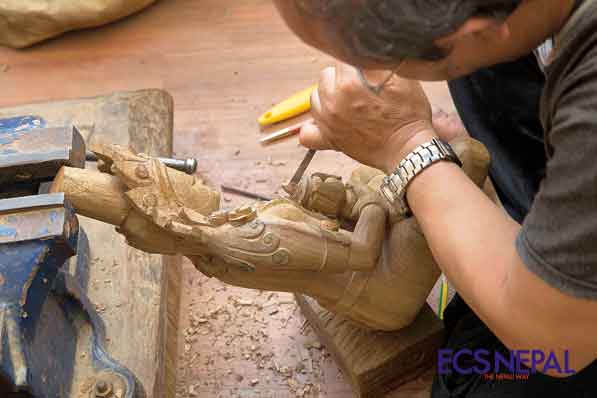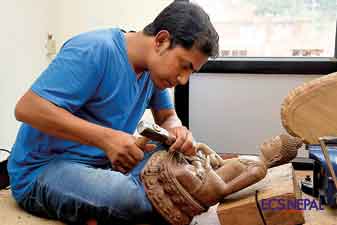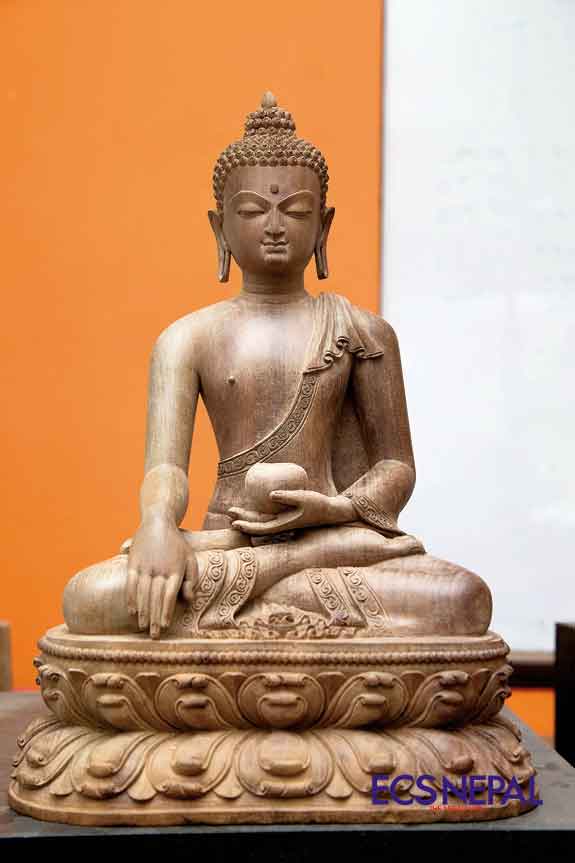An art form that speaks of the length of our history and culture, shared through a medium we need to learn more about.
Often ignored when mentioning our rich culture represented through traditional art, I first came across the beautiful craftsmanship of Nepali woodcraft when visiting a small exhibition in Patan Durbar Square. Walking into the exhibition, my eyes fall instantly on a wooden marvel, a sculpture of Aparmita. A beautiful wooden piece with a smooth finish, and extremely detailed, truly capturing the essence of the holy goddess it portrays. Now, what fascinated me the most when I saw these sculptures was the fact that each sculpture was made out of a single block of wood. The mastermind behind these beautiful works is Laxman Maharjan Tuladhar, a man who has dedicated his entire life to this art form.
When I meet him, he is sitting outside his home, and along with an accomplice, making sculpting tools out of flat metal pieces with the help of a mechanical furnace and a small bucket of water beside them. After he has finished working on the tools and is satisfied with them, we go into his quaint little workshop in Bungamati, on the outskirts of Lalitpur, and I sit down with him as he works on yet another sculpture.
I ask him how he ended up in this field, as it is a very unlikely career to pursue, and I wonder if it was something that had been passed down to him by his forefathers. He replies, “No, woodcraft wasn’t something that was passed down to me by my elders, but rather, it became a way of earning money to support my family. When I was eleven years old, my father passed away, and after that, I had to take on the responsibility of the household. I was in sixth grade at the time, and my mother couldn’t afford to keep me in school. So, I started working in woodcraft. At the time, the person in our neighboring farm worked as a woodcrafter, and I came under his wing. I’ve been in this field for years, I’m 49 years old now. That’s like, around 40 years.”

We move onto the discussion of the field itself, and the changes and difficulties he’s faced in his career as a woodcrafter, as well as the things he’s learned so far. He begins explaining, “From my experience working in this field, I have seen that, previously there weren’t places that taught woodcraft as an art form, rather, as just a means of making money. That there weren’t people who taught this craft in a way that makes people understand its beauty. The teaching tradition of woodcraft hadn’t been properly established. When people went to learn, it was more of a job than an education. When a woodcrafter had a lot of orders, the student’s duty was to be there to help him, not learn from him. It was very difficult, sometimes we wouldn’t even get paid. And, we’d have to walk all the way to Patan from Bungamati, because we didn’t even have transportation available then. Now, slowly, I see it developing more into the form of an education.”
He continues his story with a smile, as he explains the things he’s learned in his career as a woodcrafter, “When I started, I shared this thinking—the pursuit driven by money—but as I worked more and more, I realized that there is so much more that goes into this art than just knocking on wood with a sharp tool. To create these sculptures, one must have knowledge of the culture, tradition, religion, and so on. As my learning grew, I realized that there is so much more to learn that I haven’t even covered yet. This is an art that has a deeper meaning, so I think it is vital for us to gain as much knowledge about the art and the history of the figures we are representing through this art. We cannot to do whatever we like, we have to pay homage to the religious figures we are portraying through wood. This is more than just a showpiece we keep in our homes.”
When asked what it is that bring him joy in his craft, he replies with a cheery voice, “There’s many things I love about being a wood craftsman. In this craft, I get to make the statue of gods. There are many gods in our culture, but getting to learn about them individually, and learning the history and significance behind each one, is very fruitful and enjoyable. It’s not something we know on a daily basis, it’s something we have to reach out for. Reading the texts and books that cover their history, and learning more and more about our religion and history, is really interesting. It gets your imagination going and gives you a positive feeling in your heart afterwards.”

We move on to the topic of why woodcraft doesn’t seem to be as popular as other forms of traditional craft, to which he responds solemnly, “I feel like we should honor and evolve woodcraft, keeping the traditional elements of the craft, while learning and developing new elements. The teaching of woodcraft is rare, and people usually go into this field with the goal of earning money, not learning the art. Woodcraft is a beautiful art form with historic roots that are appreciated worldwide, yet maybe it’s because our society has yet to grasp its beauty or understand its importance it is often ignored in favor of other forms of craft. Which isn’t to say that other forms of craft are bad, but I do wish people would see woodcraft in a more favorable light, as well. Woodcraft is something that we must preserve, so it breaks my heart when people disregard it.”
He continues, “If I had the chance to, I would make as many sculptures as I could to contribute to the historical places like Mangalbazaar, but unfortunately, this craft is rather costly, and often, we never get the chance to showcase woodcraft as an important part of our culture.” He also adds, “I feel like we need to explore more; this is a field where no can tell you which is the right way to do so. Everyone has their own style, and if we have more people sharing their styles and evolving their style from each other, I feel like this craft would be grander. And, for that, we need more support. We also need to let skilled people have a chance to shine, so they don’t get discouraged and give up.”
“Sometimes, we feel discouraged. We feel like we will always be unappreciated, and that the months we’ve spent in carving something with such importance out of nothing but a block of wood has gone to waste, but we stay strong. I have seen people lose interest in this art because of this, and I wish that they would look at it more than as just something they do for money, and be encouraged to immerse themselves in the art and history. But, I am hopeful that people will come to appreciate woodcraft and invest in us as well, and we will soon be able to hold a larger exhibition to showcase our craftsmanship once again on a larger scale,” he ends with a slight smile, as he goes back to working on the unfinished statue in front of him.

“I feel like we should honor and evolve woodcraft, keeping the traditional elements of the craft, while learning and developing new elements."









